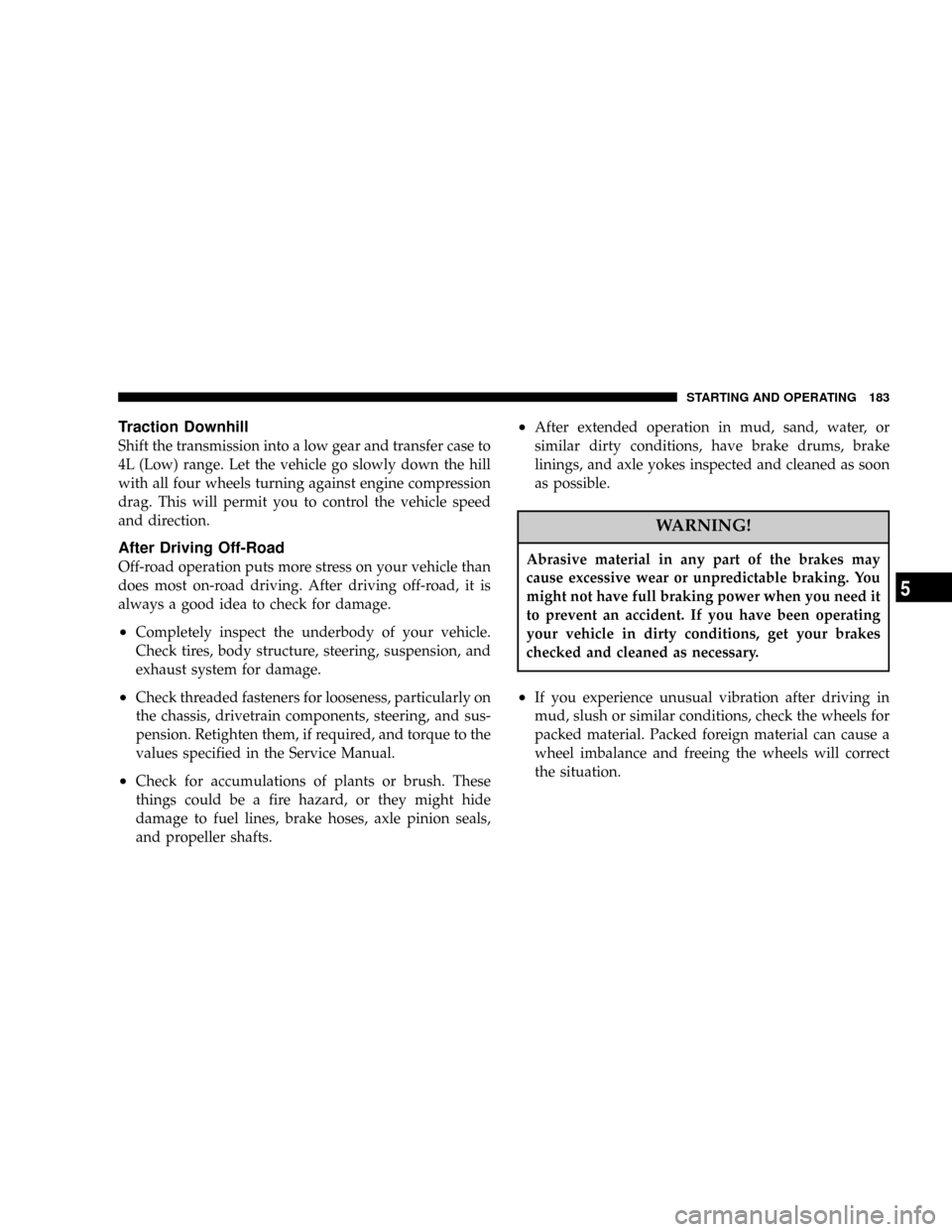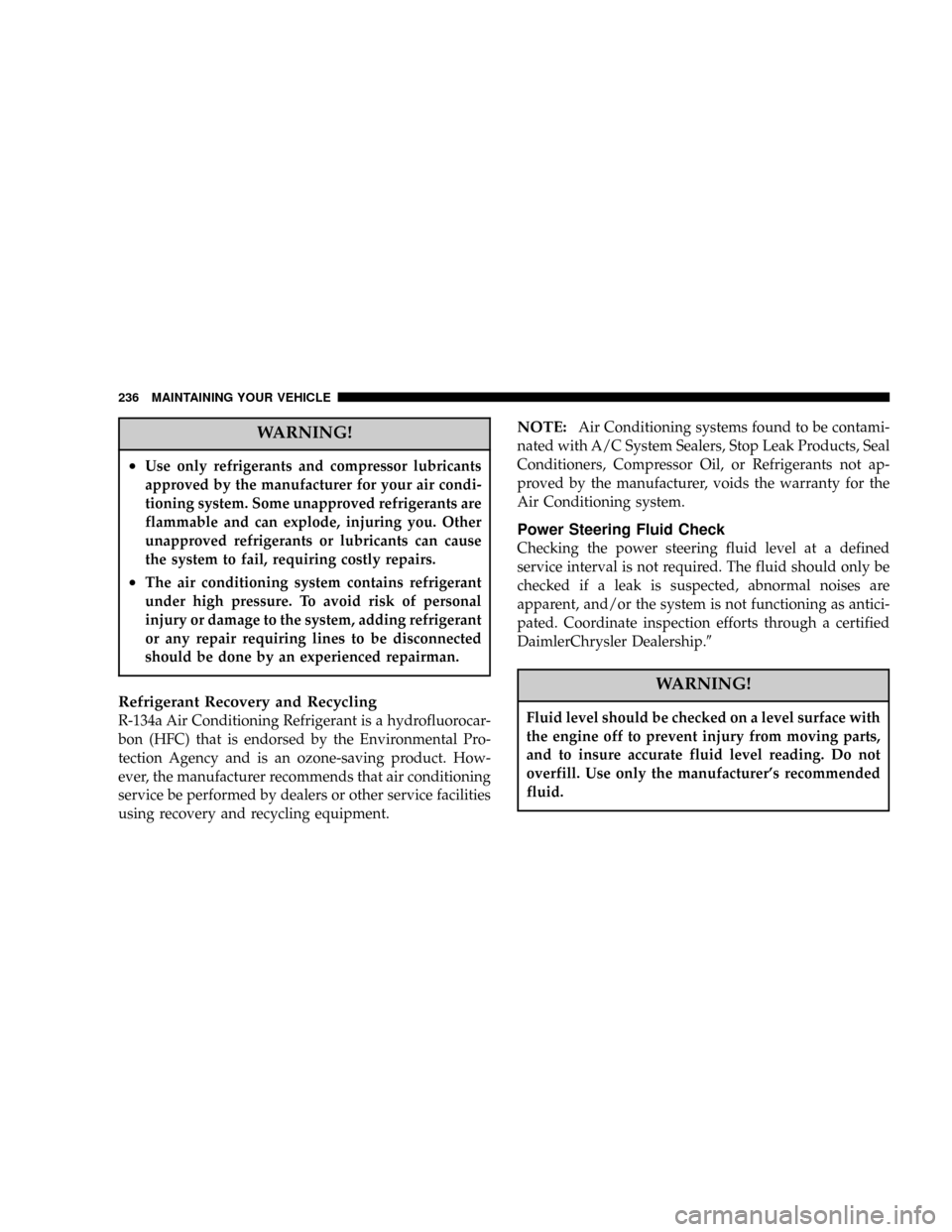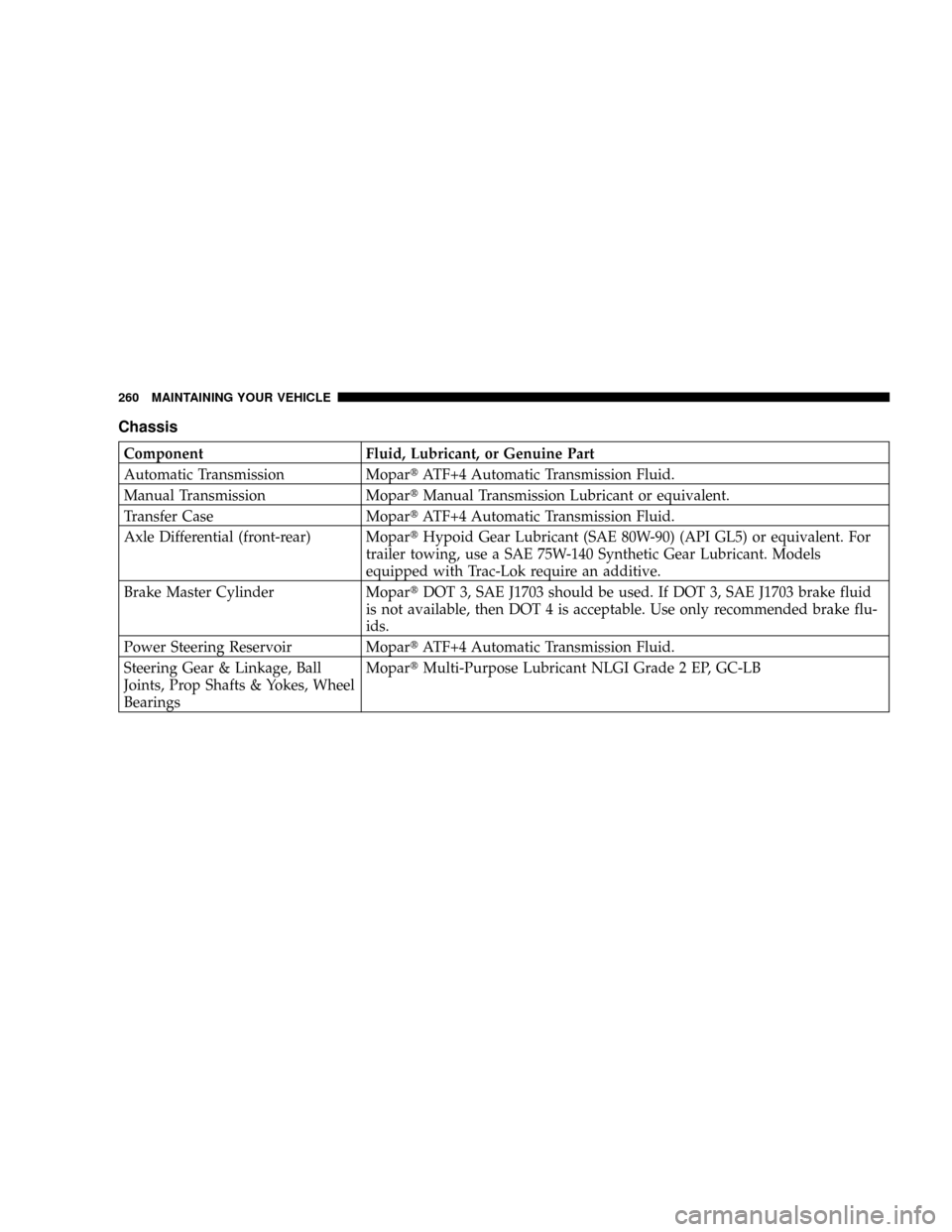power steering JEEP WRANGLER 2004 TJ / 2.G Owners Manual
[x] Cancel search | Manufacturer: JEEP, Model Year: 2004, Model line: WRANGLER, Model: JEEP WRANGLER 2004 TJ / 2.GPages: 299, PDF Size: 6.82 MB
Page 44 of 299

NDaytime Running Lights Ð Canada Only.....58
mWindshield Wipers And Washers...........58
NIntermittent Wiper System................58
NWindshield Wiper Operation..............59
NWindshield Washers....................59
NMist Feature..........................59
mTilt Steering Column.....................60
mElectronic Speed Control..................60
NTo Activate...........................61
NTo Set At A Desired Speed................61
NTo Deactivate.........................61
NTo Resume Speed......................61
NTo Vary The Speed Setting................61
NTo Accelerate For Passing................62
mCigar Lighter And Ashtrays Ð If Equipped....62
mElectrical Power Outlet...................63
NElectrical Outlet Use With Engine Off........63
mCup Holders..........................64
mStorage...............................65
NGlove Compartment....................65
NConsole Storage Compartment Ð
If Equipped..........................65
NAdd-A-TrunkŸ Ð If Equipped............65
mDual Top Ð If Equipped..................66
NRemoving The Soft Top..................66
NInstalling The Soft Top..................68
mHard Top.............................78
NHard Top Removal.....................79
NHard Top Installation...................82
44 UNDERSTANDING THE FEATURES OF YOUR VEHICLE
Page 179 of 299

WARNING!
To help avoid personal injury, follow these tips:
²Never reach through the steering wheel to operate
steering column controls. Injury to your hands or
loss of vehicle control may result.
²If the engine stalls or power assist fails due to a
malfunction, vehicle steering and braking will
require greater effort.
ANTI-LOCK BRAKE SYSTEM Ð IF EQUIPPED
The Anti-Lock Brake System is designed to aid the driver
in maintaining vehicle control under adverse braking
conditions. The system operates with a separate com-
puter to modulate hydraulic pressure to prevent wheel
lock-up and help avoid skidding on slippery surfaces.
All vehicle wheels and tires must be the same size and
type and tires must be properly inflated to produce
accurate signals for the computer.
WARNING!
Significant over or under-inflation of tires, or mixing
sizes of tires or wheels on the vehicle can lead to loss
of braking effectiveness.
The Anti-Lock Brake System conducts a low speed self-
test at about 12 mph (20 km/h). If for any reason, your
foot is on the brake when the vehicle reaches 12 mph (20
km/h), this check will be delayed until 25 mph (40
km/h).
The Anti-Lock Brake System pump motor runs during
the self-test and during an ABS stop to provide the
regulated hydraulic pressure. The motor pump makes a
low humming noise during operation, this is normal.
During off-road use, loss of traction can temporarily
defeat the system and cause the warning light to illumi-
nate. Turn the ignition OFF and ON again to restore
Anti-Lock Brake System function.
STARTING AND OPERATING 179
5
Page 183 of 299

Traction Downhill
Shift the transmission into a low gear and transfer case to
4L (Low) range. Let the vehicle go slowly down the hill
with all four wheels turning against engine compression
drag. This will permit you to control the vehicle speed
and direction.
After Driving Off-Road
Off-road operation puts more stress on your vehicle than
does most on-road driving. After driving off-road, it is
always a good idea to check for damage.
²Completely inspect the underbody of your vehicle.
Check tires, body structure, steering, suspension, and
exhaust system for damage.
²Check threaded fasteners for looseness, particularly on
the chassis, drivetrain components, steering, and sus-
pension. Retighten them, if required, and torque to the
values specified in the Service Manual.
²Check for accumulations of plants or brush. These
things could be a fire hazard, or they might hide
damage to fuel lines, brake hoses, axle pinion seals,
and propeller shafts.
²After extended operation in mud, sand, water, or
similar dirty conditions, have brake drums, brake
linings, and axle yokes inspected and cleaned as soon
as possible.
WARNING!
Abrasive material in any part of the brakes may
cause excessive wear or unpredictable braking. You
might not have full braking power when you need it
to prevent an accident. If you have been operating
your vehicle in dirty conditions, get your brakes
checked and cleaned as necessary.
²If you experience unusual vibration after driving in
mud, slush or similar conditions, check the wheels for
packed material. Packed foreign material can cause a
wheel imbalance and freeing the wheels will correct
the situation.
STARTING AND OPERATING 183
5
Page 221 of 299

MAINTAINING YOUR VEHICLE
CONTENTS
m2.4L Engine..........................223
m4.0L Engine..........................224
mOnboard Diagnostic System Ð OBD II......225
mEmissions Inspection And
Maintenance Programs
..................226
mReplacement Parts.....................227
mDealer Service........................227
mMaintenance Procedures.................228
NEngine Oil..........................228
NDrive Belts Ð Check Condition And Tension . . 231
NSpark Plugs.........................232
NCatalytic Converter....................232NEngine Timing Belt Ð 2.4L Engine.........233
NIgnition Wiring System Ð 2.4L Engine......233
NCrankcase Emission Control System........234
NFuel Filter..........................234
NEngine Air Cleaner Filter................234
NMaintenance-Free Battery................234
NAir Conditioner Maintenance.............235
NPower Steering Fluid Check..............236
NDriveline And Steering Component
Lubrication..........................237
NBody Lubrication.....................237
NWindshield Wiper Blades................237
7
Page 236 of 299

WARNING!
²Use only refrigerants and compressor lubricants
approved by the manufacturer for your air condi-
tioning system. Some unapproved refrigerants are
flammable and can explode, injuring you. Other
unapproved refrigerants or lubricants can cause
the system to fail, requiring costly repairs.
²The air conditioning system contains refrigerant
under high pressure. To avoid risk of personal
injury or damage to the system, adding refrigerant
or any repair requiring lines to be disconnected
should be done by an experienced repairman.
Refrigerant Recovery and Recycling
R-134a Air Conditioning Refrigerant is a hydrofluorocar-
bon (HFC) that is endorsed by the Environmental Pro-
tection Agency and is an ozone-saving product. How-
ever, the manufacturer recommends that air conditioning
service be performed by dealers or other service facilities
using recovery and recycling equipment.
NOTE:Air Conditioning systems found to be contami-
nated with A/C System Sealers, Stop Leak Products, Seal
Conditioners, Compressor Oil, or Refrigerants not ap-
proved by the manufacturer, voids the warranty for the
Air Conditioning system.
Power Steering Fluid Check
Checking the power steering fluid level at a defined
service interval is not required. The fluid should only be
checked if a leak is suspected, abnormal noises are
apparent, and/or the system is not functioning as antici-
pated. Coordinate inspection efforts through a certified
DaimlerChrysler Dealership.9
WARNING!
Fluid level should be checked on a level surface with
the engine off to prevent injury from moving parts,
and to insure accurate fluid level reading. Do not
overfill. Use only the manufacturer's recommended
fluid.
236 MAINTAINING YOUR VEHICLE
Page 243 of 299

Pay particular attention to the hoses nearest to high heat
sources such as the exhaust manifold. Inspect hose rout-
ing to be sure hoses do not touch any heat source or
moving component that may cause heat damage or
mechanical wear.
Insure nylon tubing in these areas has not melted or
collapsed. Inspect all hose connections such as clamps
and couplings to make sure they are secure and no leaks
are present. Components should be replaced immedi-
ately if there is any evidence of degradation that could
cause failure.
Brake System
In order to assure brake system performance, all brake
system components should be inspected periodically.
Refer to the appropriate ªMaintenance Scheduleº in
Section 8 for suggested service intervals.
WARNING!
Riding the brakes can lead to brake failure and
possibly an accident. Driving with your foot resting
or riding on the brake pedal can result in abnormally
high brake temperatures, excessive lining wear, and
possible brake damage. You wouldn't have your full
braking capacity in an emergency.
Brake and Power Steering System Hoses
When servicing the vehicle for scheduled maintenance,
inspect surface of hoses for evidence of heat and me-
chanical damage. Hard and brittle rubber, cracking, tears,
cuts, abrasion, and excessive swelling suggest deteriora-
tion of the rubber. Particular attention should be made to
examining those hose surfaces nearest to high heat
sources, such as the exhaust manifold.
Inspect all hose clamps and couplings to make sure they
are secure and no leaks are present.
NOTE:Inspection of brake hoses should be done
whenever the brake system is serviced and every engine
oil change.
MAINTAINING YOUR VEHICLE 243
7
Page 260 of 299

Chassis
Component Fluid, Lubricant, or Genuine Part
Automatic Transmission MopartATF+4 Automatic Transmission Fluid.
Manual Transmission MopartManual Transmission Lubricant or equivalent.
Transfer Case MopartATF+4 Automatic Transmission Fluid.
Axle Differential (front-rear) MopartHypoid Gear Lubricant (SAE 80W-90) (API GL5) or equivalent. For
trailer towing, use a SAE 75W-140 Synthetic Gear Lubricant. Models
equipped with Trac-Lok require an additive.
Brake Master Cylinder MopartDOT 3, SAE J1703 should be used. If DOT 3, SAE J1703 brake fluid
is not available, then DOT 4 is acceptable. Use only recommended brake flu-
ids.
Power Steering Reservoir MopartATF+4 Automatic Transmission Fluid.
Steering Gear & Linkage, Ball
Joints, Prop Shafts & Yokes, Wheel
BearingsMopartMulti-Purpose Lubricant NLGI Grade 2 EP, GC-LB
260 MAINTAINING YOUR VEHICLE
Page 289 of 299

Hoses.............................. 243
Master Cylinder...................... 244
Parking............................ 175
Warning Light....................... 119
Brakes............................... 177
Brake/Transmission Interlock.............. 166
Break-In Recommendations, New Vehicle...... 39
Bulb Replacement...................... 257
Calibration, Compass..................... 47
Capacities, Fluid....................... 258
Caps, Filler
Fuel............................... 200
Power Steering....................... 236
Car Washes........................... 249
Carpeting............................. 252
Cassette Tape and Player Maintenance....... 148
Cassette Tape Player.........126,130,132,140,142
Catalytic Converter..................... 232
Caution, Exhaust Gas..................... 40
CD Changer........................133,138
CD Player......................128,135,137
CD Player Maintenance.................. 149Cellular Phone......................... 149
Chains, Tire........................... 196
Changing A Flat Tire.................... 213
Chart, Tire Sizing....................... 185
Check Engine Light..................... 118
Child Restraint.....................29,33,36
Child Restraint Tether Anchors............. 33
Cigar Lighter........................... 62
Climate Control........................ 149
Clock................................ 120
Clutch Interlocking Ignition System......160,165
Compact Disc Maintenance............... 149
Compact Disc Player.................... 140
Compass.............................. 46
Compass Calibration..................... 47
Compass Variance....................... 48
Console............................... 65
Console, Floor.......................... 65
Contract, Service....................... 282
Converter, Catalytic..................... 232
Cooling System........................ 239
Adding Coolant (Antifreeze)............. 241
Coolant Capacity..................... 258
INDEX 289
10
Page 292 of 299

Power Steering....................... 236
Fog Lights............................. 58
Folding Rear Seat....................... 52
Folding Windshield..................... 102
Four Wheel Drive...................... 170
Shifting............................ 171
Four Wheel Drive Operation.............. 170
Front Axle............................ 248
Fuel................................. 197
Filler Cap........................... 200
Filter.............................. 234
Gasoline............................ 197
Gauge............................. 120
Materials Added...................... 199
Octane Rating........................ 197
Requirements........................ 258
Tank Capacity........................ 258
Fuel System Caution.................... 200
Fuses................................ 254
GasCap .............................. 200
Gasoline............................. 197
Gasoline, Reformulated.................. 198Gasoline/Oxygenate Blends............... 198
Gauges
Coolant Temperature................... 118
Fuel............................... 120
Odometer........................... 119
Oil Pressure......................... 117
Speedometer......................... 117
Tachometer.......................... 116
Voltmeter........................... 116
Gear Ranges........................164,166
Glass Cleaning......................... 252
Glove Compartment..................... 65
HardTop .............................. 78
Hard Top Removal...................... 79
Hazard Warning Flasher.................. 210
Headlights
Dimmer Switch....................... 57
Switch.............................. 57
Heater............................... 150
Heater, Engine Block.................... 162
High Beam Indicator.................... 117
Holder, Cup........................... 64
292 INDEX
Page 295 of 299

Mopar Parts........................227,284
Multi-Function Control Lever............... 56
New Vehicle Break-In Period............... 39
Occupant Restraints...................... 16
Octane Rating, Gasoline.................. 197
Odometer............................. 119
Trip ............................... 119
Off-Pavement Driving................... 181
Off-Road Driving....................... 181
Oil, Engine........................... 228
Capacity............................ 258
Dipstick............................ 228
Filter.............................. 231
Identification Logo.................... 230
Materials Added to.................... 231
Recommendation..................230,258
Viscosity............................ 258
Onboard Diagnostic System............225,226
Outside Rearview Mirrors................. 49
Overheating, Engine..................... 210
Owner's Manual....................... 285Paint Care............................ 248
Paint Damage......................... 248
Parking Brake......................... 175
Passenger Airbag On/Off Switch............ 26
Passing Light........................... 57
PCV Valve............................ 234
Pets.................................. 39
Pets, Transporting....................... 39
Placard, Tire and Loading Information....... 188
Polishing and Waxing................... 249
Power
Distribution Center.................... 256
Steering............................ 236
Pregnant Women and Seat Belts............. 21
Preparation for Jacking................... 213
Pressure Gauge, Oil..................... 117
Radial Ply Tires........................ 193
Radio.......................122,130,135,140
Radio Broadcast Signals.................. 121
Radio Operation..................130,135,149
Radio, Satellite......................... 145
Rear Axle............................. 248
INDEX 295
10